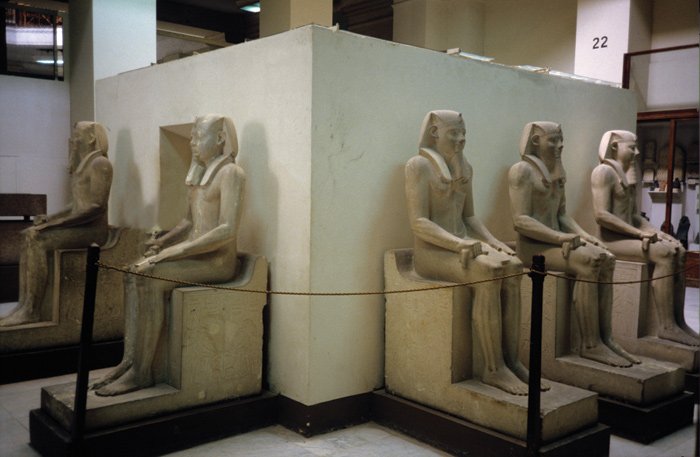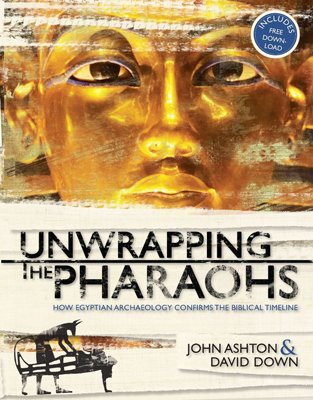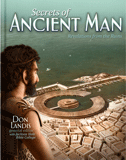
Chapter 11
The Glorious Middle Kingdom
The course of history in ancient Egypt has not been fully elucidated. Usually it has to be reconstructed from circumstantial evidence, and such is the case for the transition from the end of Dynasty 11 to the beginning of Dynasty 12. Just how this change in dynasties happened is not clear, but it may have been accomplished by a palace coup, probably assisted by a little military force.

Sesostris I of Dynasty 12 seems to have been a good king, caring for his people as a shepherd cares for his sheep. He was probably the pharaoh under whom Joseph lived.
The name “Nebtawyre” was incised on the edge of a broken bowl found at Lisht in central Egypt, and on the same bowl was the name of Wehemmesut, otherwise known as Amenemhet I, the first king of Dynasty 12. Amenemhet seems to have been the vizier or prime minister of Nebtawyre, and he left an inscription in the Wadi Hammamat. This unusual, narrow, flat valley which links the Red Sea to the Nile is one of the most unexpected gorges in Egypt, and contained rock deposits that were quarried by the ancient Egyptians for building stone. More than 200 hieroglyphic tablets have been found adorning the quarries of the renowned “bekhen” stone. One particular tablet tells how Amenemhet went there to quarry some special stone for his king’s sarcophagus. Nothing is significant about that except that it says that he took a contingent of 10,000 soldiers with him. Now that’s rather a lot of soldiers to quarry a block of stone, so the expedition may have ended in him using this military force to overthrow Nebtawyre.
In any case, Amenemhet was not short on significant happenings to support his coup. He recorded two apparent miracles which he felt endorsed his right to the throne, or at least he may have presented these miracles to the populace as evidence of his divine appointment.
The first miracle he recorded was the mysterious appearance of a gazelle that proceeded to give birth to a calf on the block of stone that had been chosen for the sarcophagus. The second miracle was a spring that suddenly appeared to provide water for the vast assembly of soldiers that accompanied him.
Another provincial governor, Knumhotep, also tells in his tomb how he accompanied the king with a flotilla of ships and fought against southerners and Asiatics. It is hard to determine who was fighting against whom, but probably it was Amenemhet’s soldiers fighting against the army of Nebtawyre.

The mud brick pyramid of Amenemhet III of Dynasty 12 at Hawarra in the Faiyyum Oasis south of Cairo.
Another line of circumstantial evidence is to be found in the writing of Neferti who lived under Amenemhet I. It is in the form of a prophecy which scholars conclude was written after it all happened, but being in the form of a prophecy was intended to support Amenemhet’s claim to the throne as being of supernatural origin.
The sage Neferti claims to have been summoned to the court of Seneferu, first king of the 4th Dynasty, in order to entertain the king with nice speeches. He wrote, “There was a time when the majesty of King Seneferu the justified was beneficent king of the whole land. . . . Then his majesty said to the seal-bearer at his side, ‘Go bring me the magistrates of the residence who have gone from here after today’s greetings.’
“They were ushered in to him and were on their bellies before his majesty a second time. His majesty said to them, ‘Comrades, I have had you summoned in order that you seek out for me a son of yours who is wise . . . so that he may speak to me some fine words, choice phrases at the hearing of which my majesty may be entertained.’”
The magistrate then recommended Neferti who was duly ushered in (also on his belly) to the presence of the king. Neferti asked the king whether he wanted to hear about the past or the future. The king naturally chose to hear about the future, so Neferti launched into his poetic discourse of some 120 lines.
Among other things he subtly wrote, “A king will come from the south. Ameny the justified by name [identified as Amenemhet], son of a woman of Ta-Seti, child of Upper Egypt . . . he will take the white crown, he will wear the red crown, he will join the two mighty ones . . . . Asiatics will fall to his sword, Libyans will fall to his flame.”1
It was all a neat bit of propaganda designed to impress the citizens of Egypt that Amenemhet I was divinely appointed to rule Egypt. Whatever the case, it ushered in an era of grandeur and power for Egypt. Dynasty 12 was one of the three great high points in Egyptian history with a proliferation of monuments. The first was the Old Kingdom, which saw the creation of the great pyramids of Giza, the second was the Middle Kingdom with Dynasty 12 at its center, and the third was the New Kingdom, commencing with Dynasty 18.
The name “Amenemhet” means “Amun is in front,” and he set about putting Egypt up in front. He established his capital city at Lisht, between Dahshur and Meidum, built a temple in the delta, and erected his pyramid near his capital city. It was not a shoddy affair such as those built in Dynasties 5 and 6. Many stones went into his pyramid, even if he had to take the stones from previous pyramids at Dahshur, Saqqara, and Giza. He conducted a military campaign against Nubia in the south, but came to a sticky end when he was assassinated.
His assailant is unknown, but there was no interruption to the monarchy. His eldest son, Sesostris, had been a co-regent with him for ten years, and he assumed the throne as Sesostris I. At least, that is the name ascribed to him in Greek writings. He seems to have had many other names, including Usertasen, Senwosret, and Kheperkere. He also conducted a military campaign into Nubia and was active in the Faiyyum Oasis, where the crocodile god Sobek was worshiped. His pyramid was 351 feet x 200 feet (107 x 61 m), with a height of 200 feet (61 m).
Judging by his statues, he seems to have been an agreeable-looking pharaoh. Ten identical statues of him were found in a pit near his pyramid at Lisht. They depict him with a pleasant face. These are now in the Cairo Museum along with a statue of him as a shepherd with staff in hand minding his sheep.
He was a great builder and erected 35 known buildings between the delta and Aswan. He built a temple at On, known in Greek as Heliopolis, which is now a suburb of Cairo. At the entrance to this temple he erected two obelisks, one of which is still standing there today. It is 67 feet (20.4 m) high and weighs 120 tons, with similar inscriptions on all four sides. It was the predecessor of the great obelisks that were later erected in the 18th and 19th Dynasties.
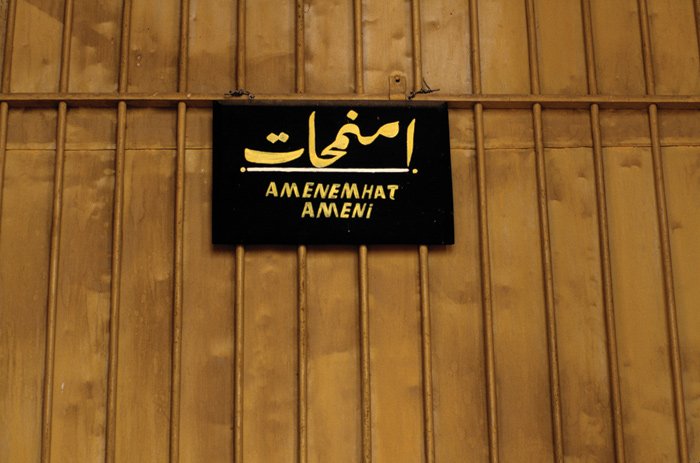
At Beni Hassan is the tomb of Ameni who was a provincial governor during the reign of Sesostris I. He records how he gathered food and stored it for the famine in his day.
Sesostris is known to have had a vizier, or prime minister, by the name of Mentuhotep who wielded extraordinary power, and some scholars have identified this vizier with the biblical Joseph. Sir Alan Gardiner assigns a date of 1971–1928 B.C. to Sesostris I, but by a revised chronology he would have been ruling when Joseph was sold as a slave into Egypt in about 1681 B.C.
According to the biblical record, Joseph was the son of Jacob, otherwise known as Israel, who had 12 sons. Joseph and Benjamin were the youngest, born to Jacob’s favorite wife, Rachel. Joseph was a good boy, but his father unwisely showed him favoritism by giving him a coat of many colors. This aroused the jealousy of his elder brothers, and when Jacob sent Joseph to visit his brothers, who were minding their flocks at Dothan, they seized Joseph and flung him into a pit. Soon after this a group of Midianite traders passed by on their way to Egypt and the brothers hauled Joseph out of the pit and sold him as a slave.
The Midianites sold Joseph to an Egyptian officer by the name of Potiphar who found Joseph to be so reliable that he promoted him to be the chief steward in his household. Unfortunately for Joseph, Potiphar’s wife took a liking to Joseph and tried to seduce him. When Joseph declined the offer, she accused him to Potiphar of trying to rape her, and Joseph was flung into prison.
The keeper of the prison also found Joseph to be very reliable and put him in charge of the other prisoners. It was during this time that Pharaoh threw two of his officers into prison and they were placed under Joseph. One day Joseph came into the prison and found the officers looking rather glum. On inquiring into the reason, they told him that they had had dreams which they could not interpret. The Egyptians attached a lot of importance to dreams, and Joseph offered to interpret them, so they related to him what they had dreamed.
Joseph interpreted the butler’s dream to mean that he would be restored to Pharaoh’s favor after three days, and the baker’s dream to mean that he would be hanged after three days. It happened just as Joseph had predicted, but before the butler left the prison, Joseph implored him to try and get him released from his imprisonment for a crime which he had not committed.
The butler assured Joseph that he would help him, but soon forgot the unfortunate Joseph. It was not until two years later when Pharaoh had some dreams that his wise men could not interpret that the butler remembered Joseph and recommended him to Pharaoh.
Joseph interpreted Pharaoh’s dreams to mean that there would be seven years of plenty in Egypt, followed by seven years of famine, and apparently it would be a very severe famine. “‘Seven years of famine will arise,’ Joseph told Pharaoh, ‘and all the plenty will be forgotten in the land of Egypt; and the famine will deplete the land’” (Genesis 41:30).
Pharaoh was convinced that Joseph had correctly interpreted his dreams and decided to appoint Joseph as the vizier to superintend the gathering of the grain during the seven years of plenty and gave him extraordinary powers to do it. “You shall be over my house, and all my people shall be ruled according to your word; only in regard to the throne will I be greater than you” (Genesis 41:40).
Mentuhotep had such power. James Breasted in his History of Egypt wrote, “When he also held the office of chief treasurer, as did the powerful vizier Mentuhotep under Sesostris I, the account which he could give of himself . . . read like the declaration of the king’s power.”2
Genesis 41:43 adds, “He [Pharaoh] had him ride in the second chariot which he had; and they cried out before him, ‘Bow the knee.’” That was the sort of status that was not usually ascribed to viziers, but it was in the case of Mentuhotep. Another great Egyptologist, Emille Brugsch, wrote in his book Egypt Under the Pharaohs, “In a word, our Mentuhotep . . . appears as the alter ego of the king. When he arrived, the great personages bowed down before him at the outer door of the royal palace.”3

A graceful canal runs from the River Nile to bring water into the Faiyyum Oasis. It is known as “Joseph’s Canal” and was dug during Dynasty 12, possibly at Joseph’s orders in preparation for the expected famine.
Pouring into the Faiyyum Oasis, 75 miles (120 km) south of Cairo, is a large canal bringing water from the River Nile. It was dug during the 12th Dynasty and is called “Joseph’s Canal.” The Faiyyum is the largest oasis in Egypt and now supports a population of 2 million people. It may be that Joseph was responsible for digging this canal to alleviate the effects of the expected drought.
In the cliffs of Beni Hassan, halfway between Cairo and Luxor, are some tombs of the 12th Dynasty. One of them belonged to Ameni, a provincial governor in the time of Sesostris I. On the wall of his tomb he wrote, “No one was unhappy in my days, not even in the years of famine, for I had tilled all the fields of the Nome of Mah, up to its southern and northern frontiers. Thus, I prolonged the life of its inhabitants and preserved the food which it produced.” Apparently, Ameni knew the famine was coming and stored the grain in readiness for the time of want.
Just south of Aswan in the Nile River is the island of Sehel. During the Greek period it was a playground for budding scribes. Every flat piece of rock was utilized by scribes practicing writing hieroglyphic texts and cutting reliefs. To hone their skills, they mostly copied or rewrote texts from earlier periods. One of the longest and most interesting of these texts is inscribed on a large rock that sits on top of a stony hill. It is known to the locals as “Hungry Rock.”
At the top of this relief is a picture of a pharaoh making an offering to three gods of the Cataract region. The writing says, “Year 18 of Horus: Neterkhet; the King of Upper and Lower Egypt: Neterkhet; Two Ladies: Neterkhet; Gold-Horus: Djoser.”
In 34 vertical columns, the text says: “I was in mourning on my throne, Those of the palace were in grief, my heart was in great affliction. Because Hapy [the river god] had failed to come in time in a period of seven years. Grain was scant, kernels were dried up, scarce was every kind of food. Every man robbed his twin, those who entered did not go. Children cried, youngsters fell, the hearts of the old were grieving; legs drawn up, they hugged the ground, their arms clasped about them. Courtiers were needy, temples were shut, shrines covered with dust, everyone was in distress.”

The inscription on “Hungry Rock” says, “Hapy [the river god] had failed to come in time in a period of seven years. Grain was scant, kernels were dried up, scarce was every kind of food.”
The severity of the famine is obvious. There is very little rainfall in Egypt, and the area is dependent on the waters of the Nile for drinking, washing, and irrigation. For the waters of the Nile to fail for one or two years was abnormal. For it to fail for seven consecutive years would be a national disaster.
The preamble to the inscription says it was during the reign of Neterkhet, an otherwise unknown king. Djoser, the first king of the 3rd Dynasty and builder of the Step Pyramid of Saqqara is added, but did the scribe who wrote this inscription get it right? He was writing more than a thousand years later and maybe he should have attributed the seven-year famine to the time of Sesostris I.
The pyramid of Sesostris I was 344 feet (105 m) square and 200 feet (61 m) high and was built at Lisht. Maspero identified it in 1882 when he found objects inscribed with the king’s name inside. The burial chamber of Sesostris has never been entered by archaeologists because it is below the water level and is filled with water. The outer casing stones have gone and only a low mound from the core remains.
Sesostris apparently cared enough for his other family members to provide small pyramids for them also. In fact, there are more small pyramids in the vicinity of his pyramid than any other pyramid builder. One was for his wife, Neferu, and another to a princess named Itayket, but the others have no names attached. In fact, there is no evidence that they were all utilized for burials. Perhaps it was better to have a few spare pyramids for family members than not enough.
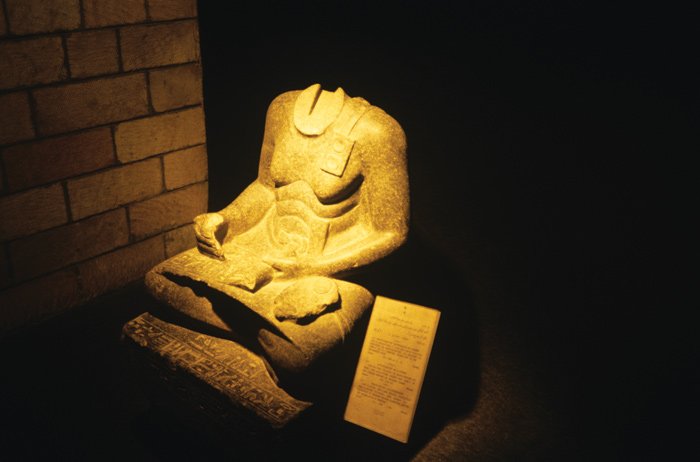
Mentuhotep, vizier under Sesostris I, may have been an Egyptian name for Joseph. His headless statue, depicting him as a scribe, is in the Luxor museum.
Sesostris I was followed by Amenemhet II and Sesostris II. The former’s pyramid at Dahshur is such a sorry mess that archaeologists cannot even work out its measurements or angle of height, so little is known about its original size. However, some tombs to the west of this pyramid yielded jewelry and personal items belonging to two of the king’s daughters.
The pyramid of Sesostris II is near the village of Lahun in the Faiyyum Oasis. It was productive of some fabulous treasures. Like the previous pyramids, it had a core of sun-dried mud bricks faced with limestone. It also had a base length of 348 feet (106 m), but it had a lower building angle which would have placed its summit at only 161 feet (49 m). It was built on a lonely rocky outcrop at the southeast corner of the Faiyyum Oasis. It was not lonely for long, because not far to the east a new city was established to accommodate the workmen and officers who were employed in building the pyramid. This well laid out city was called Ha-Usertesen-hotep.
The rocky knoll formed the foundation core of the pyramid, which was made of an enormous number of sun-dried mud bricks, though some huge stones also went into the building. The finished product was encased in smooth white limestone slabs. Today, the slabs are missing, taken by local builders of long ago, and the mud brick pyramid shape has been exposed to sun, wind, and occasional downpours of rain which have reduced it to a rounded hill.
On the north side of the pyramid are eight small, strange mastabas and a small pyramid. The mastabas were not made of stone or mud bricks, but were cut out of the bedrock which had been chiseled away, leaving the mastabas standing there. The strange feature of these structures is that the mastabas seemed to have no tomb chambers within or below them. It could only be concluded that the king, who had probably only ruled for about ten years, had died before his family members who were to have been buried there. After his demise, the other would-be burials were made elsewhere.
The intrepid British archaeologist Sir Flinders Petrie was the main excavator who endeavored to make the pyramid yield its secrets and its treasures. His first self-appointed task in 1899 was to locate the entrance to the tomb chamber, and this proved to be a problem. Most pyramids followed the traditional practice of making the entrance on the north side, but after Petrie had spent much time in fruitless searching he concluded that this pyramid was different.
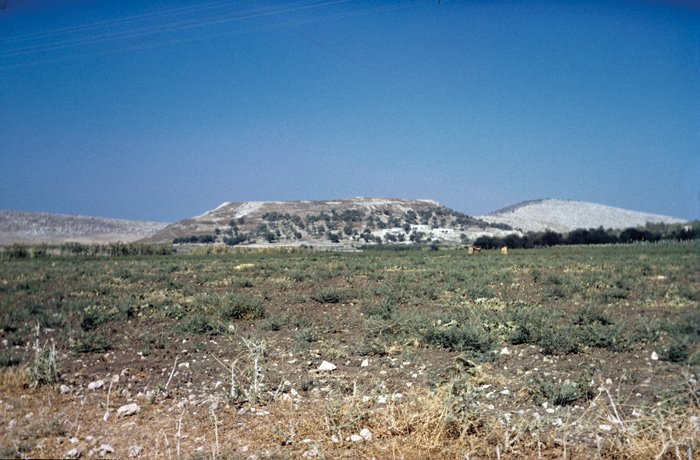
The city of Dothan in Israel was built on this hill. Joseph found his brothers grazing their sheep at Dothan (Gen. 37:17).
He eventually found that the tomb chamber was cut into the solid rock on which the pyramid had been built, and in this tomb Petrie found the king’s sarcophagus, which made a big impression even on this skilled and experienced archaeologist. In his book Ten Years Digging in Egypt, Petrie wrote:
“The sarcophagus is one of the finest products of mechanical skill that is known from ancient times. It is of red granite, of a form not before met with, having a wide rectangular brim. The surfaces are all ground flat, but not polished; truth, and not effect, was sought for. And its errors in work of flatness and regularity are not more than the thickness of a visiting card. Its accuracy of proportion is also fine, as each dimension is a whole number of palms, with a fluctuation of only one part in a thousand.”4
The tomb chamber was also a remarkable engineering effort. It had been lined with stone and the ceiling was made of large slabs of stone in the form of a gabled roof with the underside rounded.
Papyri found in the nearby city, now called Kahun, revealed that a large number of the inhabitants of this city were from Palestine or Syria, and should be identified with the Israelite slaves that descended from Jacob. Whether these were the ones responsible for the skilled workmanship cannot be determined, but undoubtedly these Israelite slaves were involved in the building program.
In the city Petrie also found evidence which he claimed pointed to the origins of the alphabet. Until that time writing was done in laborious hieroglyphs or hieratic script, but Petrie wrote:
“Marks of various kinds are found on pieces of pottery-vessels here, some put on by the maker before the baking, but mostly scratched by the owner. These marks are many of them derived from the Egyptian workmen’s signs, corruptions of hieroglyphs. But as we shall see in the next chapter, the discoveries at Gurob point to these having some kinship with the Western alphabets. They are therefore the venerable first step in adopting marks to represent sounds, irrespective of their primitive form and significance.”5
In his next chapter, Petrie concluded, “It will require a very certain proof of the supposed Arabian source of the Phoenician alphabet to deny that we have here the origin of the Mediterranean alphabets.”6
But Petrie’s discoveries were only the beginning. Some of the most exquisite jewelry ever found in Egypt was found in this pyramid, and it was found as the result of some dogged determination and meticulous care by the archaeologists involved.

The mud brick pyramid of Sesostris II in the Faiyyum Oasis. It was originally faced with smooth stones but these have been taken leaving the mound of bricks exposed.
Petrie returned to Lahun in 1914 and commenced to thoroughly scour the tomb chamber and passages. Petrie considered that nothing that was found was unimportant, a view taken for granted today, but was considered rather unnecessary in his day. His first search produced some beads, pottery, a small piece of gold, and some gold leaf. Then came an important find—a solid gold uraeus, the striking cobra displayed at the front of the king’s crown. The head was of lapis-lazuli, the eyes were of inlaid garnet, turquoise, and lapis stone. The uraeus must have belonged to Sesostris, and some bones believed to belong to the pharaoh were found.
Aidan Dodson, writing in the spring 2000 edition of KMT, tells the story of another exciting discovery which was made nearby.7 The find was made in the tomb of Princess Sithathoriunet. The workmen had dug a shaft on the south side of Sesostris’ pyramid, and near this shaft they found the tomb of the princess. On the floor of this tomb chamber was a thick layer of dried mud which had been washed in from rains that had occurred over the centuries. When they began to remove this silt, they discovered some gold beads. Further excavating produced more gold beads and ivory inlay, two flint razors with golden handles, mirrors, pectorals, then more gold beads and more gold beads. They finally decided that the only way to make sure they missed none of the beads was to remove the silt to their camp and immerse the silt in water. The silt floated and the beads dropped to the bottom. More than 9,500 beads were ultimately recovered.
The mystery was, though, how these priceless beads came to be embedded in mud. The conclusion drawn was that the jewelry had originally been in a casket which had disintegrated over the centuries. As successive layers of mud were washed into the tomb, the jewelry had been gradually engulfed.
The removal of the treasures to Cairo was no less dramatic. The archaeologists locked them in a box and deposited them in a safe in the Egyptian Museum. When the digging season was ended, the archaeologists went to the museum and retrieved the box. They asked the museum director, Gaston Maspero, to leave the room while they laid out the jewelry in all its original splendor. When Maspero was invited back into the room and saw all the sparkling treasures he was almost speechless.

A statue of Sesostris I stands beside his obelisk in Heliopolis. A pair of obelisks once stood outside his temple here.
But that was not the end of the story. Maspero allowed Petrie to take the treasure out of Egypt. Petrie displayed it to the British Museum to make an offer, but Wallis Budge was the keeper of the museum, and he had no love for Petrie. Wallis made an offer of 2,000 pounds, which was declined. Instead, Petrie gathered up his treasures and sold them to the Metropolitan Museum in New York, where they are on display today.
Putting all the beads and other jewelry together in their right shape was a rather speculative task, and since they were first put on display some of them have been regrouped, but they are recognized as being some of the finest jewelry ever to be found in Egypt.
These findings give us some idea of life in Egypt at the time when the Israelites first moved there.
Unwrapping the Pharaohs
Adults and children alike are fascinated by Egyptian civilization. But most modern archaeologists have lately tried to use Egyptian chronology to dispute the biblical record. Secular textbooks and videos challenge the faith of students and discredit the biblical account of Exodus. Those who wish to defend the accuracy of the Bible now have an incredible tool in this exciting book that provides compelling confirmation of the biblical account.
Read Online Buy BookFootnotes
- Miriam Lichtheim, Ancient Egyptian Literature, Volume 1, “The Old and Middle Kindoms” (Berkeley, CA: University of California Press, 1975), p. 140-143.
- James Henry Breasted, A History of Egypt (New York: Scribner and Sons, 1954), p. 166.
- Ibid., p. 162.
- W.M. Flinders Petrie, Ten Years’ Digging in Egypt (Chicago, IL: Ares Publishers Inc., 1976), p. 109.
- Ibid., p. 121.
- Ibid., p. 133.
- Aidan Dodson, “A Great Find Revisited; Lahun and Its Treasure,” KMT (A Modern Journal of Ancient Egypt), vol. 11, no. 1 (2000): p. 38-49.
Recommended Resources

Answers in Genesis is an apologetics ministry, dedicated to helping Christians defend their faith and proclaim the good news of Jesus Christ.
- Customer Service 800.778.3390
- © 2024 Answers in Genesis

